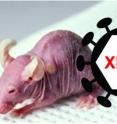Origins of XMRV deciphered, undermining claims for a role in human disease
Delineation of the origin of the retrovirus known as XMRV from the genomes of laboratory mice indicates that the virus is unlikely to be responsible for either prostate cancer or chronic fatigue syndrome in humans, as has been widely published. The virus arose because of genetic recombination of two mouse viruses. Subsequent infection of lab experiments with XMRV formed the basis of the original association. Reporting in Science, Vinay Pathak, Ph.D., and his research team from the National Cancer Institute (NCI), part of the National Institutes of Health, in collaboration with other researchers, described experiments that provide an understanding of when and how XMRV arose and explain the original, incorrect association. XMRV stands for xenotropic murine leukemia virus–related virus.
This study is being reported in the same issue of Science as another study of XMRV (Knox et al.) that finds a lack of association between the virus and CFS even in the same patients from a 2009 study. "Taken together, these results essentially close the door on XMRV as a cause of human disease," said John Coffin, Ph.D., special advisor to the NCI director, and professor at Tufts University School of Medicine, a coauthor of the paper with Pathak.
Murine leukemia viruses are retroviruses that cause cancers and other diseases in mice. They are divided into different classes, one of which is xenotropic murine leukemia viruses. Although viruses in this class cannot grow in or infect cells from most mice, in the laboratory they can infect cells from other species, including human cells.
XMRV was first reported in samples from a human prostate tumor in 2006, and has been reported to be present in 6 percent to 27 percent of human prostate cancers. Later research reported XMRV in the blood of 67 percent of people with CFS.
The assertion that XMRV is circulating in the human population has been challenged by several studies that have failed to detect XMRV in multiple sets of specimens from people with prostate cancer or CFS and healthy controls.
To try to resolve the degree of association between XMRV and human disease, Pathak, who led these studies at NCI in its Viral Mutation Section, Coffin, and their colleagues examined human prostate cancer cells which contained XMRV, as well as the tumors from which these prostate cell specimens arose after they were grafted into mice. Grafting human tumors, called xenografts, into mice is a common way to study disease when it might be unsafe to test new treatments or methods in humans.
Upon careful examination in this new study, it was shown that initial prostate tumor xenografts did not contain XMRV but later tumors that had been derived from them did, demonstrating that XMRV was not present in the original human tumor as previously supposed. Instead, the virus appears to have infected tumor cells while they were in mice. In addition, the mice that were used for xenografting the prostate tumor cells contained two previously undescribed viruses, PreXMRV‐1 and PreXMRV‐2. Each of these viruses has a stretch of over 3,200 nucleotides, the basic building blocks of DNA, which is nearly identical to XMRV, differing by only a single nucleotide.
Genetic comparison of the PreXMRV‐1 and PreXMRV‐2 sequences revealed that each one has non-overlapping stretches that are nearly identical to XMRV. Pathak, Coffin, and their colleagues postulate that recombination between these viruses generated XMRV in human cells while the cells were being grown in a mouse sometime between 1993 and1996 and infected the prostate tumor cells. Recombination between virus genomes in a cell infected by more than one virus is common.
Based on this genetic analysis, the scientists concluded that XMRV was not present in the original prostate tumor samples but arose only after they had been put into mice. The probability that an identical recombination event occurred independently is about 1 in 1 trillion, making it extremely unlikely that XMRV arose from another source. The researchers concluded that the association of XMRV with human disease is due to contamination of samples with virus originating from this recombination event.
"After the reports of XMRV in human prostate cancer, and later of XMRV in people with CFS, retrovirologists all over the world were excited to explore its role in human infection and disease. The results published today are not what we would have expected, but due to the time and resources dedicated to the understanding of this virus by researchers at NCI and NIH as well as others, scientists can now concentrate on identifying the real causes of these diseases," said Pathak.
Source: NIH/National Cancer Institute
Articles on the same topic
- Mouse virus erroneously linked to chronic fatigue syndrome, UCSF collaborative study findsTue, 31 May 2011, 23:37:29 UTC
Other sources
- New Data Spark Retraction Request for Chronic Fatigue Virus Studyfrom Science NOWThu, 2 Jun 2011, 18:50:17 UTC
- Virus No Longer Thought to Be Cause of Chronic Fatigue Syndromefrom Scientific AmericanWed, 1 Jun 2011, 17:00:24 UTC
- Mouse virus erroneously linked to chronic fatigue syndrome, study findsfrom Science DailyTue, 31 May 2011, 23:31:15 UTC
- Origins of XMRV deciphered, undermining claims for a role in human diseasefrom PhysorgTue, 31 May 2011, 16:01:28 UTC
- Mouse virus erroneously linked to chronic fatigue syndrome, study findsfrom PhysorgTue, 31 May 2011, 14:30:53 UTC
